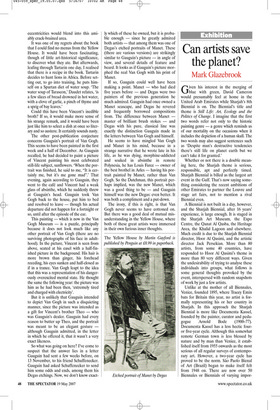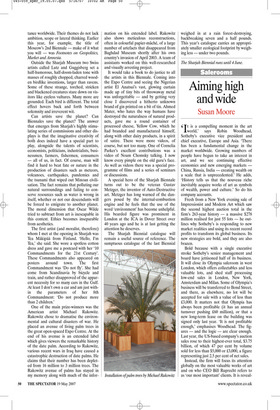Can artists save the planet?
Mark Glazebrook
Given his interest in the merging of blue with green, David Cameron would presumably feel at home in the United Arab Emirates while Sharjah’s 8th Biennial is on. The Biennial’s title and theme is Still Life: Art, Ecology and the Politics of Change. I imagine that the first two words refer not only to the historic painting genre — a genre which reminds us of our mortality on the occasions when it includes the depiction of a human skull. The two words may also suggest sentences such as ‘Despite man’s destructive tendencies there’s still life on planet earth but we can’t take it for granted.’ Whether or not there is a double meaning here, the Sharjah theme is serious, responsible, apt and perfectly timed. Sharjah Biennial is billed as the largest art event in the Gulf. That’s now saying something considering the recent ambitions of other Emirates to partner the Louvre and stage art fairs, not to mention a rival Biennial even.
A Biennial is not built in a day, however, and the Sharjah Biennial, after 16 years’ experience, is large enough. It is staged in the Sharjah Art Museum, the Expo Centre, the Qanat Al Qasba, the Heritage Area, the Khalid Lagoon and elsewhere. Much credit is due to the Sharjah Biennial director, Hoor Al Qasimi, and the artistic director Jack Persekian. More than 80 artists, from some 40 countries, have responded to Hoor Al Qasimi’s theme in more than 80 very different ways. Given the undesirability of trying to analyse these individuals into groups, what follows is some general thoughts provoked by the event, interspersed with random snapshots of work by just a few artists.
Unlike at the mother of all Biennales, Venice, founded 1895, where Tracey Emin bats for Britain this year, no artist is formally representing his or her country in Sharjah. In this approach the Sharjah Biennial is more like Documenta Kassel, founded by the painter, curator and pedagogue Arnold Bode (1900–77). Documenta Kassel has a less hectic fouror five-year cycle. Although this somewhat remote German town is less blessed by nature and by man than Venice, it established itself from 1955 onwards as the most serious of all regular surveys of contemporary art. However, a two-year cycle has proved to be the norm. São Paolo Bienal of Art (Brazil) began to make itself felt from 1948 on. There are now over 50 Biennales or Biennials of varying impor tance worldwide. Their themes do not lack ambition, scope or lateral thinking. Earlier this year, for example, the title of Moscow’s 2nd Biennale — make of it what you will — was Footnotes on Geopolitics, Market and Amnesia.
Outside the Sharjah Museum two Swiss artists called Lutz and Guggisberg set a half-humorous, half-doom-laden tone with masses of roughly chopped, charred wooden birdlike inventions, larger than ravens. Some of these strange, torched, stricken and blackened creatures stare down on visitors like eyeless vultures. Many more are grounded. Each bird is different. The total effect hovers back and forth between solemnity and irreverent wit.
Can artists save the planet? Can Biennales save the planet? The answer that emerges from Sharjah’s highly stimulating series of commissions and other displays is that the imaginative creativity of both does indeed have a special part to play, alongside the talents of scientists, economists, politicians, industrialists, businessmen, farmers, fishermen, consumers — all of us, in fact. Of course, man will find it hard to beat fate or nature in the production of disasters such as meteors, volcanoes, earthquakes, pandemics and the tsunami that wiped out Minoan civilisation. The fact remains that polluting our natural surroundings and failing to conserve resources such as water is wrong in itself, whether or not our descendants will be forced to emigrate to another planet. The moral dimension that Oscar Wilde tried to subtract from art is inescapable in this context. Ethics becomes inseparable from aesthetics.
The first artist (and moralist, therefore) whom I met at the opening in Sharjah was Tea Mäkipää from Finland. ‘Hello, I’m Tea,’ she said. She wore a spotless cotton dress and gave me a postcard with her ‘10 Commandments for the 21st Century’. These Commandments also appeared on posters around town. The first Commandment was ‘Do not fly’. She had come from Scandinavia by bicycle and train, and rather disapproved of the apparent necessity for so many cars in the Gulf. At least I don’t own a car and am just within the parameters of her 8th Commandment: ‘Do not produce more than 2 children.’ One of the main prize-winners was the American artist Michael Rakowitz. Rakowitz chose to dramatise the environmental and cultural disasters of war. He placed an avenue of living palm trees in the great open-spaced Expo Centre. At the end of his avenue is an extended label which gives viewers the remarkable history of the date palm. According to Rakowitz, various recent wars in Iraq have caused a catastrophic destruction of date palms. He claims that their number has been depleted from 16 million to 3 million trees. The Rakowitz avenue of palms has stayed in my memory along with much of the infor mation on his extended label. Rakowitz also shows meticulous reconstructions, often in colourful papier-mâché, of a large number of artefacts that disappeared from Baghdad Museum shortly after his own country’s invasion of April 2003. A team of assistants worked on this well-researched and visually arresting project.
It would take a book to do justice to all the artists in this Biennale. Coming into the Expo Centre and seeing the Nigerian artist El Anatsui’s vast, glowing curtain made up of tiny bits of throwaway metal was unforgettable — and by getting very close I discovered a hitherto unknown brand of gin printed on a bit of tin. Ahmed Mater, who hates the way humans have destroyed the naturalness of natural products, gave me a round container of processed cheese, Yellow Cow, which he had branded and manufactured himself, along with other dairy products, in a spirit of satire. There were more videos, of course, but not too many. One of Cornelia Parker’s excellent contributions was a video of Noam Chomsky talking. I now know every pimple on the old guru’s face. As well as videos there was a special programme of films and a series of seminars or discussions.
A special hero of the Sharjah Biennale turns out to be the veteran Gustav Metzger, the inventor of Auto-Destructive art. Metzger has long warned of the dangers posed by the internal-combustion engine and he feels that the use of the word ‘environment’ has become unhelpful. His bearded figure was prominent in London at the ICA in Dover Street over 40 years ago and he is at last getting the attention he deserves.
The Sharjah Biennial catalogue will remain a useful source of reference. The sumptuous catalogue of the last Biennial weighed in at a rain forest-destroying, backbreaking seven and a half pounds. This year’s catalogue carries an appropriately smaller ecological footprint by weighing less — under two pounds.











































































 Previous page
Previous page